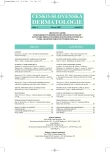Distribution of Basal Cell Carcinoma according to Histological Type, Localization, Age and Sex
Authors:
Y. Vantuchová 1; R. Cuřík 2
Authors‘ workplace:
Kožní oddělení Fakultní nemocnice v Ostravě
primářka MUDr. Yvetta Vantuchová
1; Ústav patologie Fakultní nemocnice v Ostravě
přednosta MUDr. Romuald Čuřík
2
Published in:
Čes-slov Derm, 82, 2007, No. 3, p. 140-145
Category:
Clinical and laboratory Research
Overview
During three years 1998–2000, 259 patients with 320 basal cell carcinomas were examined at the dermatooncological clinic of The Faculty Hospital of Ostrava. Four types of basaliomas were differentiated: nodular, infiltrating, superficial and basosquamous. There were 56.8% of males and 43.2% of females in the group, multiple tumors were more often recorded in males. 68.4% of tumors were situated on the head, 22.5% on the trunk, 9.1% on the limbs. Localization on the head was noted in 80% of infiltrating basaliomas, 81.3% of basosquamous type, 69.1% of nodular type and 63.2% of superficial type. The most common tumor on the trunk was superficial type (29.6%). The mean age of nodular and superficial basal cell carcinoma diagnosis was the same in both sexes and it was four years higher than the mean age of the diagnosis of the infiltrating type. Nodular and superficial basal cell carcinomas were more frequently diagnosed between 60–79 years, infiltrating carcinoma was diagnosed between 60–79 years in males, in females mostly between 40–59 years. Basosquamous type was more often recorded in higher age group in females when compared to males.
Key words:
basal cell carcinoma – histological type – age – sex – anatomic distribut
Labels
Dermatology & STDs Paediatric dermatology & STDsArticle was published in
Czech-Slovak Dermatology

2007 Issue 3
Most read in this issue
- Distribution of Basal Cell Carcinoma according to Histological Type, Localization, Age and Sex
- Aneurysmal Fibrous Histiocytoma of the Skin (Description of 2 Cases)
- Lithium and the Skin
- Quantitative Analysis of Circulating Melanoma Cells for Early Detection of Disease Progression
